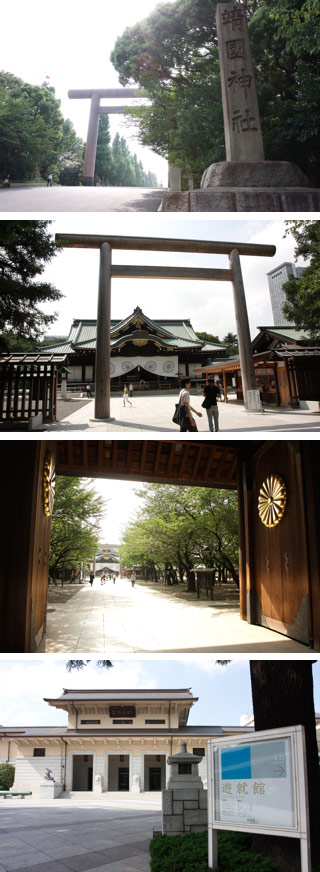Yasukuni Shrine was established in 1869 by Emperor Meiji for loyal citizens who had died for Meiji Restoration which was the one of the most important revolution in Japanese history. Before Meiji Restoration began, Japan had imposed ifself a period of isolation, which lasted over a long time. Evetually, the United States and Other nations began to pressure Japan to open its door and market to the world.
Such demands threw Japan into turmoil, with its decision-makers polarized into two camps, one for and one against continuing isolation. The Tokugawa Shogunate had retained control over Japanese politics for 300 years. However, lacking the power to resolved this crisis, the Shogunate returned the reins of government to the Emperor.
These efforts were marred by the outbreak of an unavoidable conflict that broke out during the Meiji Restoration, in which many people lost their lives. Emperor Meiji, wishing to honor the memory of those who had died for their country, ordered the construction of a shrine for that purpose. The shrine was established at Kudan, Tokyo in June 1869, at which time it was given the name Shokonsha. In 1879, it was renamed Yasukuni Jinja (shrine).
Deities
At Yasukuni Shrine, there enshrined many people who sacrificed themselves in the Boshin War, the Saga Uprising and the Seinan War. These wars broke out as the starting point of modern Japan. Among the enshrined are Yoshida Shoin and Sakamoto Ryoma who are famous historic figures for their activities which lead to the Meiji Restoration. Also enshrined are many soldiers who died in wars such as the Sino-Japanese War, the Russo-Japanese War, the First World War, the Manchurian Incident, the China Incident, and the Greater East Asian War (Second World War) to protect their country. Currently, there are more than 2,466,000 divinities enshrined at the shrine.
Not only soldiers' spirits are enshrined here, but also other people are enshrined. There are women’s and school girls’ divinities who were involved in relief operation on battlefields, a great number of students who went to work in factories for the war effort. There also enshrined ordinary Japanese citizens, Taiwanese and Korean people died as Japanese, the people who died during the Siberian detaining, and who were labeled war criminals and executed after having been tried by the Allies.
Here at Yasukuni Shrine, these people, regardless of their rank or social standing, are considered to be subject of completely equal respect and worshipping because the only puropose of the shrine is to commemorate those who sacrificed their lives for their nation. That is, the 2,466,000 divinities enshrined at Yasukuni Shrine are all sacrificed their lives to the public duty of protecting their motherland.
Worshiping
Foreigners will understand the nature of Yasukuni Shrine comparing with similar facilities in their countries if they are explained that the shrine is a place for Japanese people to show their appreciation and respect to those who died to protect their mother country, Japan.
The difference between Yasukuni Shrine and other foreign memorial institutions for war dead is that the shrine enshrines the spirits of those who died on public duty of protecting their mother land. This difference might be causing misunderstanding. However, the nature of the shrine has its origin in the traditional Japanese way of thinking which is to commemorate the deceased eternally by enshrining them as object of worship. It is not an abnormal institution.
Probably, people who cherish their own culture will understand the difference and will understand the importance of Yasukuni Shrine which was established for commemorate and to show appreciation and respect to those who dedicated their precious lives to their mother country.
Today, many people visit Yasukuni Shrine regardless to their religion, thought and nationalities. This fact tells that the shrine is a place to show respect to those who died to protect their mother country and that the shrine has public nature.
Here is a list of major festivals held at Yasukuni Shrine.
January 1
Shinnensai (New Year's Festival)
February 11
Kenkoku kinensai (National Foundation Day) Anniversary of the day on which Japan's first Emperor, Jinmu, is said to have founded our nation.
February 17
Kinensai (Spring Festival for Harvest)
April 21-23
Shunki Reitaisai (Annual Spring Festival)
April 29
Showasai (Showa Festival) Emperor Showa's birthday
June 29
Gosoritsu Kinenbisai (Founding Day) Commemoration of the founding of Yasukuni Jinja
July 13-16
Mitama Matsuri
October 17-20
Shuki Reitaisai (Annual Autumn Festival)
November 3
Meijisai (Emperor Meiji's Birthday)
November 23
Niinamesai (Festival of First Fruits)
December 23
Tenno gotanshin Hoshukusai (Birthday of the Current Emperor)
The first, 11th and 21st day of each month
Tukinamisai
Everyday
Asa Mikesai, Yu Mikesai, Eitai Kagurasai (Perpetual Kagura Festivals)
Yushukan
Yushukan is a museum to inherit sincerity and records of enshrined divinities of Yasukuni Shrine by displaying their historically important wills and relics.
Open daily
9:00 a.m. - 5:00 p.m.
during Mitama Festival (July 13-16)
9:00 a.m. - 9:00 p.m.
Note: We close for a few days in late June and late December
Admission fee:
Adults:
800 yen (640 yen)
University students:
500 yen (400 yen)
High/Junior High School students:
300 yen (240 yen)
Elementary and middle-school students:
100 yen (80 yen)
Official Web site : http://www.yasukuni.or.jp/english/index.html






